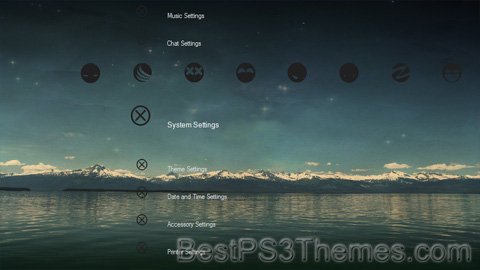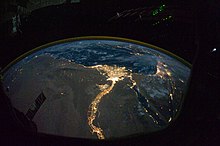Night theme by iwoohoo
Download: Night.p3t

(1 background)

Night or nighttime is the period of darkness when the Sun is below the horizon. The opposite of nighttime is daytime. Sunlight illuminates one side of the Earth, leaving the other in darkness. Earth's rotation causes the appearance of sunrise and sunset. Moonlight, airglow, starlight, and light pollution dimly illuminate night. The duration of day, night, and twilight varies depending on the time of year and the latitude. Night on other celestial bodies is affected by their rotation and orbital periods. The planets Mercury and Venus have much longer nights than Earth. On Venus, night lasts 120 Earth days. The Moon's rotation is tidally locked, rotating so that the near side of the Moon always faces Earth. Nightfall across the near the side of the Moon results in the lunar phases visible from Earth.
Organisms respond to the changes brought by nightfall, including darkness, increased humidity, and lower temperatures. Their responses include direct reactions and adjustments to circadian rhythms, governed by an internal biological clock. These circadian rhythms, regulated by exposure to light and darkness, affect an organism's behavior and physiology. Animals more active at night are called nocturnal and have adaptations for low light, including different forms of night vision and the heightening of other senses. Diurnal animals are active during the day and sleep at night; mammals, birds, and some others dream while asleep. Fungi respond directly to nightfall and increase their biomass. With some exceptions, fungi do not rely on a biological clock. Plants store energy produced through photosynthesis as starch granules to consume at night. Algae engage in a similar process, and cyanobacteria transition from photosynthesis to nitrogen fixation after sunset. In arid environments like deserts, plants evolved to be more active at night, with many gathering carbon dioxide overnight for daytime photosynthesis. Night-blooming cacti rely on nocturnal pollinators such as bats and moths for reproduction. Light pollution disrupts the patterns in ecosystems and is especially harmful to night-flying insects.
Historically, night has been a time of increased danger and insecurity. Many daytime social controls dissipated after sunset. Theft, fights, murders, taboo sexual activities, and accidental deaths all became more frequent due in part to reduced visibility. Cultures have personified night through deities associated with some or all of these aspects of nighttime. The folklore of many cultures contains "creatures of the night," including werewolves, witches, ghosts, and goblins, reflecting societal fears and anxieties. The introduction of artificial lighting extended daytime activities. Major European cities hung lanterns housing candles and oil lamps in the 1600s. Nineteenth-century gas and electric lights created unprecedented illumination. The range of socially acceptable leisure activities expanded, and various industries introduced a night shift. Nightlife, encompassing bars, nightclubs, and cultural venues, has become a significant part of urban culture, contributing to social and political movements.
Astronomy[edit]
A planet's rotation causes nighttime and daytime. When a place on Earth is pointed away from the Sun, that location experiences night. The Sun appears to set in the West and rise in the East due to Earth's rotation.[1] Many celestial bodies, including the other planets in the solar system, have a form of night.[1][2]
Earth[edit]

The length of night on Earth varies depending on the time of year. Longer nights occur in winter, with the winter solstice being the longest.[3] Nights are shorter in the summer, with the summer solstice being the shortest.[3] Earth orbits the Sun on an axis tilted 23.44 degrees.[4] Nights are longer when a hemisphere is tilted away from the Sun and shorter when a hemisphere is tilted toward the Sun.[5] As a result, the longest night of the year for the Northern Hemisphere will be the shortest night of the year for the Southern Hemisphere.[5]
Night's duration varies least near the equator. The difference between the shortest and longest night increases approaching the poles.[6] At the equator, night lasts roughly 12 hours throughout the year.[7] The tropics have little difference in the length of day and night.[6] At the 45th parallel, the longest winter night is roughly twice as long as the shortest summer night.[8] Within the polar circles, night will last the full 24 hours of the winter solstice.[5] The length of this polar night increases closer to the poles. Utqiagvik, Alaska, the northernmost point in the United States, experiences 65 days of polar night.[9] At the pole itself, polar night lasts 179 days from September to March.[9]

Over a year, there is more daytime than nighttime because of the Sun's size and atmospheric refraction. The Sun is not a single point.[10] Viewed from Earth, the Sun ranges in angular diameter from 31 to 33 arcminutes.[11] When the center of the Sun falls level with the western horizon, half of the Sun will still be visible during sunset. Likewise, by the time the center of the Sun rises to the eastern horizon, half of the Sun will already be visible during sunrise.[12] This shortens night by about 3 minutes in temperate zones.[13] Atmospheric refraction is a larger factor.[10] Refraction bends sunlight over the horizon.[13] On Earth, the Sun remains briefly visible after it has geometrically fallen below the horizon.[13] This shortens night by about 6 minutes.[13] Scattered, diffuse sunlight remains in the sky after sunset and into twilight.[14]

There are multiple ways to define twilight, the gradual transition to and from darkness when the Sun is below the horizon.[15] "Civil" twilight occurs when the Sun is between 0 to 6 degrees below the horizon. Nearby planets like Venus and bright stars like Sirius are visible during this period.[16] "Nautical" twilight continues until the Sun is 12 degrees below the horizon.[17] During nautical twilight, the horizon is visible enough for navigation.[18] "Astronomical" twilight continues until the Sun has sunk 18 degrees below the horizon.[16][19] Beyond 18 degrees, refracted sunlight is no longer visible.[19] The period when the sun is 18 or more degrees below either horizon is called astronomical night.[17]
Similar to the duration of night itself, the duration of twilight varies according to latitude.[19] At the equator, day quickly transitions to night, while the transition can take weeks near the poles.[19] The duration of twilight is longest at the summer solstice and shortest near the equinoxes.[20] Moonlight, starlight, airglow, and light pollution create the skyglow that dimly illuminates nighttime.[21][22] The amount of skyglow increases each year due to artificial lighting.[21]
Other celestial bodies[edit]
Night exists on the other planets and moons in the solar system.[1][2] The length of night is affected by the rotation period and orbital period of the celestial object.[23] The lunar phases visible from Earth result from nightfall on the Moon.[24] The Moon has longer nights than Earth, lasting about two weeks.[23] This is half of the synodic lunar month, the time it takes the Moon to cycle through its phases.[25] The Moon is tidally locked to Earth; it rotates so that one side of the Moon always faces the Earth.[26] The side of the Moon facing away from Earth is called the far side of the Moon and the side facing Earth is called the near side of the Moon. During lunar night on the near side, Earth is 50 times brighter than a full moon.[27] Because the Moon has no atmosphere, there is an abrupt transition from day to night without twilight.[28]

Night varies from planet to planet within the Solar System. Mars's dusty atmosphere causes a lengthy twilight period. The refracted light ranges from purple to blue, often resulting in glowing noctilucent clouds.[29] Venus and Mercury have long nights because of their slow rotational periods.[30] The planet Venus rotates once every 243 Earth days.[31] Because of its unusual retrograde rotation, nights last 116.75 Earth days.[32] The dense greenhouse atmosphere on Venus keeps its surface hot enough to melt lead throughout the night.[33][34] Its planetary wind system, driven by solar heat, reverses direction from day to night. Venus's winds flow from the equator to the poles on the day side and from the poles to the equator on the night side.[35][36] On Mercury, the planet closest to the Sun, the temperature drops over 1,000 °F (538 °C) after nightfall.[37]
The day-night cycle is one consideration for planetary habitability or the possibility of extraterrestrial life on distant exoplanets.[38] Some exoplanets, like those of TRAPPIST-1, are tidally locked. Tidally locked planets have equal rotation and orbital periods, so one side experiences constant day, and the other side constant night. In these situations, astrophysicists believe that life would most likely develop in the twilight zone between the day and night hemispheres.[39][40]
Biology[edit]
Living organisms react directly to the darkness of night.[42] Light and darkness also affect circadian rhythms, the physical and mental changes that occur in a 24-hour cycle.[43] This daily cycle is regulated by an internal "biological clock" that is adjusted by exposure to light.[43] The length and timing of nighttime depend on location and time of year.[44] Organisms that are more active at night possess adaptations to the night's dimmer light, increased humidity, and lower temperatures.[45]
Animals[edit]
Animals that are active primarily at night are called nocturnal and usually possess adaptations for night vision.[46] In vertebrates' eyes, two types of photoreceptor cells sense light.[47] Cone cells sense color but are ineffective in low light; rod cells sense only brightness but remain effective in very dim light.[48] The eyes of nocturnal animals have a greater percentage of rod cells.[47] In most mammals, rod cells contain densely packed DNA near the edge of the nucleus. For nocturnal mammals, this is reversed with the densely packed DNA in the center of the nucleus, which reduces the scattering of light.[49] Some nocturnal animals have a mirror, the tapetum lucidum, behind the retina. This doubles the amount of light their eyes can process.[50]

The compound eyes of insects can see at even lower levels of light. For example, the elephant hawk moth can see in color, including ultraviolet, with only starlight.[46] Nocturnal insects navigate using moonlight, lunar phases, infrared vision, the position of the stars, and the Earth's magnetic field.[51] Artificial lighting disrupts the biorhythms of many animals.[52] Night-flying insects that use the moon for navigation are especially vulnerable to disorientation from increasing levels of artificial lighting.[53] Artificial lights attract many night-flying insects that die from exhaustion and nocturnal predators.[54] Decreases in insect populations disrupt the overall ecosystem because their larvae are a key food source for smaller fish.[55] Dark-sky advocate Paul Bogard described the unnatural migration of night-flying insects from the unlit Nevada desert into Las Vegas as "like sparkling confetti floating in the beam's white column".[56]
Some nocturnal animals have developed other senses to compensate for limited light. Many snakes have a pit organ that senses infrared light and enables them to detect heat. Nocturnal mice possess a vomeronasal organ that enhances their sense of smell. Bats heavily depend on echolocation.[57] Echolocation allows an animal to navigate with their sense of hearing by emitting sounds and listening for the time it takes them to bounce back.[57] Bats emit a steady stream of clicks while hunting insects and home in on prey as thin as human hair.[58]

People and other diurnal animals sleep primarily at night.[59] Humans, other mammals, and birds experience multiple stages of sleep visible via electroencephalography.[60] The stages of sleep are wakefulness, three stages of non-rapid eye movement sleep (NREM) including deep sleep, and rapid eye movement (REM) sleep.[61] During REM sleep, dreams are more frequent and complex.[62] Studies show that some reptiles may also experience REM sleep.[63] During deep sleep, memories are consolidated into long-term memory.[64] Invertebrates most likely experience a form of sleep as well. Studies on bees, which have complex but unrelated brain structures, have shown improvements in memory after sleep, similar to mammals.[65]
Compared to waking life, dreams are sparse with limited sensory detail. Dreams are hallucinatory or bizarre, and they often have a narrative structure.[66] Many hypotheses exist to explain the function of dreams without a definitive answer.[66] Nightmares are dreams that cause distress. The word "night-mare" originally referred to nocturnal demons that were believed to assail sleeping dreamers, like the incubus (male) or succubus (female).[67] It was believed that the demons could sit upon a dreamer's chest to suffocate a victim, as depicted in John Henry Fuseli's The Nightmare.[67]
Fungi[edit]

Fungi can sense the presence and absence of light, and the nightly changes of most fungi growth and biological processes are direct responses to either darkness or falling temperatures.[44] By night, fungi are more engaged in synthesizing cellular components and increasing their biomass.[68] For example, fungi that preys on insects will infect the central nervous system of their prey, allowing the fungi to control the actions of the dying insect. During the late afternoon, the fungi will pilot their prey to higher elevation where wind currents can carry its spores further. The fungi will kill and digest the insect as night falls, extending fruiting bodies from the host's exoskeleton.[69] Few species of fungi have true circadian rhythms.[44] A notable exception is Neurospora crassa, a bread mold, widely used to study biorhythms.[70]
Plants[edit]
During the day, plants engage in photosynthesis and release oxygen. By night, plants engage in respiration, consuming oxygen and releasing carbon dioxide.[71] Plants can draw up more water after sunset, which facilitates new leaf growth.[72] As plants cannot create energy through photosynthesis after sunset, they use energy stored in the plant, typically as starch granules.[73] Plants use this stored energy at a steady rate, depleting their reserves almost right at dawn.[73] Plants will adjust their rate of consumption to match the expected time until sunrise. This avoids prematurely running out of starch reserves,[73] and it allows the plant to adjust for longer nights in the winter.[74] If a plant is subjected to artificially early darkness, it will ration its energy consumption to last until dawn.[74]
Succulent plants, including cacti, have adapted to the limited water availability in arid environments like deserts.[75] The stomata of cacti do not open until night.[76] When the temperature drops, the pores open to allow the cacti to store carbon dioxide for photosynthesis the next day, a process known as crassulacean acid metabolism (CAM).[76][77] Cacti and most night-blooming plants use CAM to store up to
